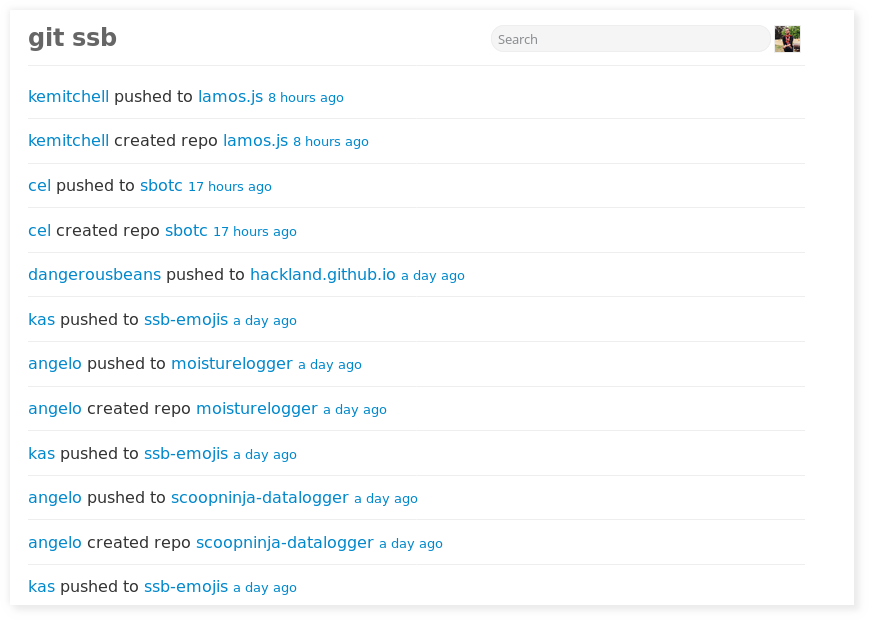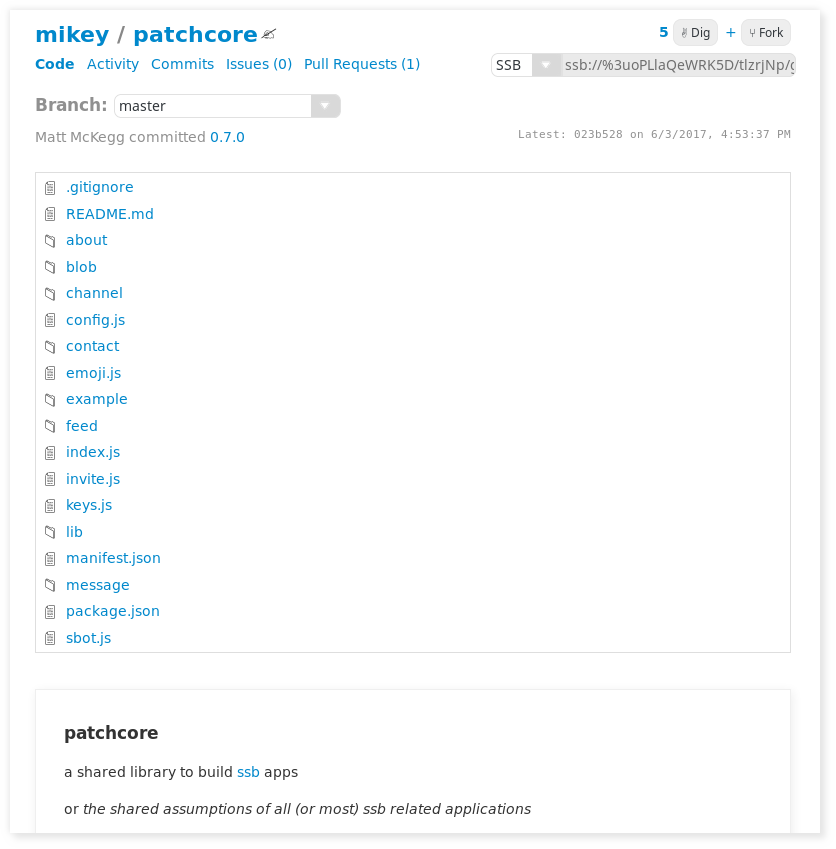git-ssb-intro
a guide to hacking together on the distributed web
If you're curious about the distributed web, and the prospect of using git collaboratively without a central, closed-source point of origin, you came to the right place!
git-ssb is a great fit for just this. This guide tries to act as a transition aide for GitHub users into the world of git-ssb. It assumes rudimentary knowledge of GitHub. It will walk through:
- understanding what "SSB" is.
- installing ssb-server -- the SSB peer server -- and joining the network.
- installing the
git-ssbcommand and thegit-ssb-webweb interface. - a walkthrough of using git-ssb to do common GitHub workflows (creating repos, making pull requests, merging pull requests, issues, etc).
A view of recent activity among my friends on git-ssb
What is SSB?
SSB stands for secure scuttlebutt, the database/protocol that powers the peer-to-peer log store scuttlebutt. There is a great deal of information to be found by reading these sites, if you're so inclined.
If you're familiar with bitcoin or blockchains, SSB is akin to having your own personal blockchain: you can append messages of any kind, with any data you'd like. Unlike bitcoin, there's no money involved: it's just a data structure on your local machine.
Your personal log can only be appended to, and is cryptographically secure: each message references the hash of the message that came before it. The whole thing is then also signed by your public key, making it both tamper-proof, and appendable only by the private key holder (you).
The final piece of SSB that makes it all work is the gossip protocol: when you run scuttlebutt, you become a peer in a network of other scuttlebutt users. You can choose to 'follow' other people's personal logs. As a result, whenever you see that user (or any user that follows that user too) online, you can retrieve their latest log entries from them. All without any central server or central authentication.
git-ssb builds on top of this: things like commits, branches, issues, and pull requests are encoded into log entries on each participant's personal log, while the gossip protocol runs in the background and propagates new content to everyone involved in the git repository.
Setup
If you're already up and running on Patchwork (or another client), you can skip to step 3.
1. Install node + npm
You can install node and npm..
- from https://nodejs.org, or
- using nvm
2. Install an SSB node
Any SSB node should do; there are several implementations. Below we will focus on two of the most popular.
Whichever you choose, make sure you get an invite code from a pub to increase your ability to find other scuttlers.
Desktop GUI: Patchwork
Patchwork is an easy and user-friendly client that's nice to start your SSB experience with, if you're new. Follow the instructions on the main page at https://scuttlebutt.nz
If you're looking for a 'headless'/CLI node to provide SSB services, follow the next section.
Command-Line Interface: ssb-server
The ssb-server is a local secure scuttlebutt server which will manage replicating data with other peers.
3. Install ssb-npm
All of the dependencies for git-ssb and git-ssb itself live on the SSB network. To access them, we'll need to install ssb-npm:
First, install the ssb-npm-registry plugin:
sbot plugins.install npm-registry --from 'http://localhost:8989/blobs/get/&2afFvk14JEObC047kYmBLioDgMfHe2Eg5/gndSjPQ1Q=.sha256'
If this doesn't work (or you aren't following enough people) you can fetch the blob from a centralized source too:
sbot plugins.install npm-registry --from 'http://viewer.scuttlebot.io/&2afFvk14JEObC047kYmBLioDgMfHe2Eg5/gndSjPQ1Q=.sha256'
Restart SSB, then install the ssb-npm command:
npm install -g 'http://localhost:8989/blobs/get/&qcphVNO9k28QT0oASdyjH41XEySuTxX3STooEj+olEE=.sha256'
If you have problems with the above commands you may need to follow different people, so that you can find all the dependencies. cel is a good bet.
4. Install git-ssb
git-ssb is primarily the work of cel, and comes in the form of a command-line program not unlike git or GitHub's hub.
Let's use npm to install git-ssb globally so we can use it in the command-line:
ssb-npm install -g git-ssb --branch %p0H9aCwnOiyFHvFU2o7lFURhOx8VqygW3cS4jlhb66s=.sha256
You can now run git-ssb (or git ssb) from the command line and get a feel for the sorts of things it can do.
NOTE - git-ssb needs an SSB node to work with. You must ensure Patchwork, ssb-server, or simiar is running when executing git-ssb commands.
The git-ssb web interface
If you've already joined the SSB network successfully, you can take a look at
what other hackers on SSB are working on! Run git-ssb web and point your web
browser at the URL it outputs. (Remember you need to be running ssb-server or Patchwork.)
A repo on git-ssb
You'll see that it's not dissimilar from GitHub: git-ssb-web lets you see commit activity, view repositories, browse commit history, see issues and pull requests. All without a centralized authority.
There are at least a few public git-ssb web servers run by the community, for browsing git-ssb content without running your own ssb-server:
Creating your first SSB git remote
git-ssb makes ssb-server act like a git remote. Navigate to an existing git repository of yours and run
$ git-ssb create ssb my-little-repo
This will create a new git repo on SSB. The command will output something that looks like
Created repo: ssb://%DEvlJYD+zuudMyNWFBjiiNvZ8DbOyBYhCkE5EVtWSV0=.sha256
(my-little-repo)
The string %DEvlJYD+zuudMyNWFBjiiNvZ8DbOyBYhCkE5EVtWSV0=.sha256 is a hash that
uniquely identifies your git-ssb repository. To see this in action, you can
navigate to (for example) ~/projects and run
$ git clone ssb://%DEvlJYD+zuudMyNWFBjiiNvZ8DbOyBYhCkE5EVtWSV0=.sha256 my-repo
and you'll see that ~/projects/my-repo now exists. git-ssb talked to your local
ssb-server server and pulled down the entire git repository.
In fact, you can also view your handiwork by running git-ssb web and opening
your browser: you'll see your brand new repo near the top of the activity list
and can browse it like you might've on GitHub.
Collaboration: forks and pull requests
If you're reading this article, then you've already found one SSB git repository: this one! Let's create a fork, make some changes, and send a pull request:
Clone
$ git clone ssb://%RPKzL382v2fAia5HuDNHD5kkFdlP7bGvXQApSXqOBwc=.sha256 git-ssb-intro
$ cd git-ssb-intro
Fork
Let's look at the help with git-ssb fork --help:
Usage: git ssb fork [<upstream>] <remote_name>
Create a new git-ssb repo as a fork of another repo
and add it as a git remote
Arguments:
upstream id, url, or git remote name of the repo to fork.
default: 'origin' or 'ssb'
remote_name Name for the new remote
since we just did a fresh git clone, the remote to the original repo is
origin; you can type git remote -v and have a look. since origin (or
ssb) are the default for forks, you can omit this option.
remote_name is whatever you'd like to call the remote of your fork. I usually
call mine noffle-ssb, to indicate that it's a fork remote and that it's my
personal one:
$ git-ssb fork noffle-ssb
Created repo: ssb://%DKWLuN05qtwjdwTG7zCG4aU12muBK2pkpYgaBbeVkTM=.sha256 (git-ssb-intro)
Added remote: noffle-ssb
Great! Now we can make some changes and commit them. I forgot to add a license to this document, so we can add that, commit, and push:
$ cat >> README.md
# license
ISC
^D
$ git commit -am 'adds license'
[master 3a7c5f7] adds license
1 file changed, 4 insertions(+)
$ git push noffle-ssb
Counting objects: 3, done.
Delta compression using up to 2 threads.
Compressing objects: 100% (2/2), done.
Writing objects: 100% (3/3), 2.55 KiB | 0 bytes/s, done.
Total 3 (delta 0), reused 0 (delta 0)
Decoding objects: 100% (3/3)
Pushing blobs...pwMeF/zIvuwFc4/T3VBwpHr+r6H+dHvWKFyIxCs1+08=.sha256
Published %i0Fcr3zRdf50Tin1UdEmYU38eKWthmkO3XgpfMYU1AU=.sha256ha256
To ssb://%DKWLuN05qtwjdwTG7zCG4aU12muBK2pkpYgaBbeVkTM=.sha256
6a701c2..3a7c5f7 master -> master
We can see our fork on the web interface, too! navigate to
http://localhost:7718 and you'll see your repo fork.
Let's finally create a pull request with our changes:
$ git-ssb pull-request
this will launch your text editor and let you type in a message. It's good practice to make the first line of your message the subject, and leave two newlines before writing your message. something like
test pull request
please merge me
Sure enough, you can now navigate to the from-github-to-git-ssb repo on SSB
and see your pull request:
http://localhost:7718/%25RPKzL382v2fAia5HuDNHD5kkFdlP7bGvXQApSXqOBwc%3D.sha256/pulls
If you were the owner of the git repo, you could merge this pull request from the command line by pulling down the fork remote and merging:
git fetch ssb://%RPKzL382v2fAia5HuDNHD5kkFdlP7bGvXQApSXqOBwc=.sha256 noffle-ssb:noffle-ssb
git merge noffle-ssb
git push ssb
Alternative: collaboration without forks
git-ssb's permissionless model has an interesting consequence: anybody can push to anybody else's git repository. Coming from a GitHub background this probably sounds like madness, but folks on SSB have been using this model with good success. A pull request might look like this:
$ git clone ssb://%RPKzL382v2fAia5HuDNHD5kkFdlP7bGvXQApSXqOBwc=.sha256 foobar
$ git checkout -b @noffle/master
$ cd foobar
$ vim index.js
(edit edit edit)
$ git commit -am 'wark'
$ git push ssb
$ git ssb pull-request
The nomenclature is to treat the ssb remote as the "true" remote, and work off
of a branch called @your-username/master as your own master, emulating a
forked repo. This seems to work well: the SSB network thrives off of being a
group of kind, respectful folks who don't push to each other's master branch.
:)
Push conflicts
Since git-ssb allows users to push to the same remote asynchronously, there is a
possibility that they will conflict. This is different from a git merge
conflict: in this case, there are two (or more) competing HEADs for e.g.
master.
If this happens, git-ssb will consider the branch as being in a conflict state. It will automatically add a new "conflict branch" for each conflicting HEAD. The name of each conflict branch will be prefixed by its SSB message ID. To resolve the conflict, one should merge the conflict branches locally as appropriate, and then push the new head and delete the conflict branches. e.g.:
git checkout master
git fetch origin
git merge origin/%msg1/master [origin/%msg2/master...]
# resolve merge conflict
...
git push origin master -d %msg1/master [-d %msg2/master...]
Go forth and collaborate!
Well done, and welcome to the scuttleverse and the world of distributed social coding! share git-ssb with your friends, and consider managing an SSB remote of your GitHub work, to encourage further growth of the distributed web.
Thanks for reading! please share feedback or questions as issues on this repo, or, if you find any errors in the text, send a pull request.
Contributors
- @noffle: wrote this doc
- @cel: answered my many questions, and wrote most of the section on "push conflicts"
- @mixmix: several clarifications and improvements
License
CC0


